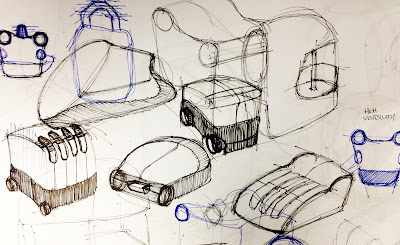Theme: "Solidworks"
Introduction
This week the design team outlined the final deliverables for the semester project. The outcomes which needed to be achieved by the end of the week included, developing a fully resolved interaction concept design, designing a 3D prototype model using CAD, creating presentation boards and making two short films which will examine the form and overall functionality of our design. My task for this week was to design the main substation and model it using a 3D modelling program called Solidworks. My main aim while designing the substation was to make sure that it addressed the user's needs and was both relevant and useful for the context. In addition, I believed the substation needed to be seamlessly integrated into the user's scenario in order for it to be effective, helpful and actually improve the experience for the user. In order for me to achieve this I developed my own phrase "purpose driven design" to help guide my design process and stay focused.
Firstly, I decided to conduct preliminary research on the context to determine what properties the main sub station would require.
- Indoor/Outdoor working conditions. Therefore, consider portability and materials;
- Dirty floors with various chemicals, dust and grime;
- Constant need to utilize floor space. Therefore, floor space needs to always be clear in order to ensure a safe working environment. The main substation will most likely need to be placed on the wall or carried by the site manager to make sure there is always someone monitoring the substation and the information it is collecting/displaying. However, after a discussion with the team they informed me that the device must remain on the floor to comply with industry standards;
- Electrical wires from various machines and equipment can usually be a hazard and as a result, could affect the positioning of the main sub station;
- Noise disturbance could reduce the effectiveness of the main sub station. Therefore, the substation must remain visual and relatively close by at all times;
- Majority of the time the worker is looking down on the floor and unaware of what is going on around them; and
- The overall context is relatively dangerous, loud and can be overcrowded at times.
Based on these findings and observations, the main substation is required to have the following features/aspects:
- Highly visible from all directions;
- Robust;
- Lightweight;
- Durable;
- Portable and easily transportable; and
- System of LED lights to notify the manager.
Listed below are a few conceptual diagrams and form development sketches relating to the above research.
The main substation only has four LED emitting nodes. A hierarchy system is used in the substation to notify the site manager as to which workers are experiencing the worst pain or discomfort. The idea of only using four LED emitting nodes is to eliminate the need for the manager to monitor and keep record of all their workers. Using this system the site manager is able to only focus on the workers that require their attention immediately.
Furthermore, the main substation directly links to the glove and power socket. Therefore, all three of these components form a system, a system of information which is transferred from one product to the next. Each time information sis transferred it is evaluated by both the user and the product. Depending on the user's behaviours and experience the user or product will act accordingly Each component is a vital link to ensure the information is correctly analysed and acted upon.
Over the course of the week I with the help of Nick Kallinicos designed and developed the main substation. Below are the technical drawings and associated screen shots showing the different stages of the design development.

















No comments:
Post a Comment